JAIN SAINTS
ACHARYA LOKESH INAUGURATED PARLIAMENT OF WORLD'S RELIGIONS AT SALT LAKE CITY, USA
Acharya Dr. Lokesh Muni eminent Jainacharya and founder of Ahimsa Vishwa Bharti speaking at the inaugural session Parliament of World’s Religions organised at Salt Lake City of United States of America said that Ahimsa or Nonviolence is the need of present world when humanity is facing the problems of war, violence and terrorism. As preached by Bhagwan Mahavir, we have to practice nonviolence in our everyday life.
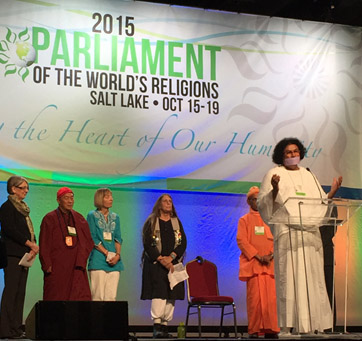 |
He said that we all respect our own philosophies and believes but we should give equal importance and respect to what others believe in. Acharya Lokesh quoting Jain Philosophy said that war and hatred of humanity. Practicing non violence can make this world a peaceful and better place o live in. Many other religious leaders also addressed the inauguration session.
Achrya Lokesh with many other religious leaders inaugurated the Exhibition of Mahatma Gandhi, Jain Temple and Langar at the Parliament of World’s Religions venue before addressing the inaugural session. He also had discussion with Parliament of World Religions Chairperson Malik Mujahid about establishment of Peace, Nonviolence and Harmony in the world.
It is noteworthy that representatives from around 80 countries participated in Parliament of World’s Religions organisedfrom 15 to 19 October at Salt Lake City Utah in USA. Parliament of World Religions is organised in USA after every four years, Swami Vivekanand ji and Shri Virchand Raghav ji Gandhi made Indian Cultural values and philosophy proud by addressing the first Parliament of World Religion organised in 1893.
CONFERENCE REPORT: 15.10.15: Opening Ceremony of Parliament of World’s Religions: Founder of Ahimsa Vishwa Bharti Acharya Dr. Lokesh Muni representing Jain religion at the Inauguration Ceremony of Parliament of World’s Religions said that Bhagwan Mahavir gave the message of Ahimsa (Non-violence), Aparigriha (Renunciation) and Anekant (Unity in Diversity) to the world. Presently there is a predominant need of Philosophy of Ahimsa. War, Violence and Terrorism cannot solve any problem; Violence gives rise to counter violence. Bhagwan Mahavir philosophy can make the dream of World Peace come true. Presenting Jain Prayer Acharya Lokesh recited Namaskar Maha Mantra and Mangal Path. Acharya Lokesh with religious leaders of different faiths raised their hands together to conclude the inaugurations ceremony which was welcomed by thousands of people with grand applause. In this inaugurations ceremony Board Trustee of Parliament of World’s Religions and Ex-President of JAINA Mr. Kirit C. Daftary gave remarkable contribution.
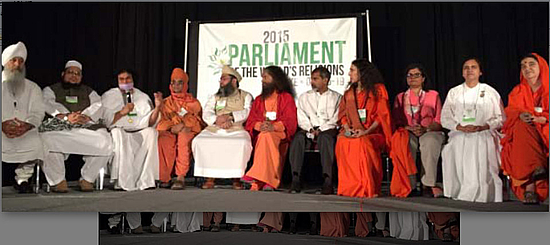 |
Chairman of Parliament of World’s Religions Imam Malik Mujahhudin welcomed all the representatives at the inauguration function. Message of United Nations Secretary General Ban Ki Moon was read out. Governor and Mayor of Salt Lake City graced the occasion with their presence. Acharya Lokesh concluded the program by raising hands in a gesture of unity with all the religious leaders which was welcomed by the audience with applause.
Inaugurated the Jain Temple - Acharya Dr. Lokesh Muni addressing the inauguration program of Jain Temple in the Convention Centre of Parliament of World’s Religion said that by constructing Jain Temple at Parliament of World’s Religion Venue Bhagwan Mahavir message of Non-violence through more than ten thousand representatives from around 80 countries will spread to the world masses. The replica of Jain temple was constructed with the remarkable efforts of JAINA (Federation of Jain Associations in North America) and Mr. Kirit C. Daftary. Acharya Lokesh appreciating the efforts made by JAINA and Board Trustee of Parliament of World’s Religions and Ex-President of JAINA Mr. Kirit C. Daftary for this remarkable work recited Mangal Path on the occasion. The program began with Namaskar Mantra recitation by Samani Parimal Pragya Ji. Shri Amarendra Muni Ji, Bhattarak Shri Charukirti Ji, Swamy Chidanand Saraswati Ji from Hindu religion, Swamy Madhavpriy Das Ji from Swaminarayan Temple, Bhai Satpal Singh Ji Maharaj from Sikh Religion congratulated Jain Community on the occasion. Shri Kirit Bhai Daftary presented the Vote of Thanks.
16.10.15: Session ‘Resolving Conflict, Promoting Peace: Acharya Dr. Lokesh Muni eminent Jainacharya and founder of Ahimsa Vishwa Bharti addressing the session organised on the theme ‘Resolving Conflict, Promoting Peace (Application of Ahimsa, Anekant, Aparigriha) gave speech on the subject ‘Peace Education to end War, Violence and Hatred’. He said that our present education system only takes care of the physical and intellectual development of children there is no curriculum for mental and emotional growth. Advocating the introduction of Peace Education in our education system he said that there is a need to amalgamate moral education in the system.
Acharya Lokesh said that United Nation’s cultural organization UNESCO in its explanatory doctrine reminds us that the idea of war and violence first germinate in human brain cells. Physiognomy of human brain is in two hemispheres. Reasoning and logical thinking is processed in the Left hemisphere of the human brain and right hemisphere nourishes emotions and empathy. The personality is formed largely by the cells in which part of the brain are more active. Anger, hate, sense of revenge and other negative feelings are prompted by brain cells.
17.10.15: Worship to WASH- Religious Leaders come together for Water, Sanitation and Hygiene’: Eminent Jainacharya Acharya Dr. Lokesh Muni addressing ‘Worship to WASH- Religious Leaders come together for Water, Sanitation and Hygiene’ first congratulated Global Interfaith Wash Alliance which has tried to create awareness in the world through social revolution ‘WASH’ by organizing programs during Parliament of World’s Religions. He said that 85 % of world’s total population believes in some faith and they accept their religious preachers with unending faith. It is the duty of such religious Guru to aware their lakhs of followers towards ‘WASH’. By doing this untimely death of thousands of children can be stopped. Our religious scripture says that "शरीर माद्यं खलु धर्म साधनम्" we cannot do any religious work or social work without proper health. That is why we should spread the feelings of WASH among people for social, economical and religious development of the world.
He assured GIWA on behalf of 69 Jain Centers established in America and 10 million Jains all over the world that Jain Community and Ahimsa Vishwa Bharti will work for this mission. On the occasion Swamy Chidanand Saraswati, Ven. Bhikku Sanghasena, Sadhvi Bhagwati, Maulana Luqman Tarapuri, Swamy Madavpriy Das Ji, Imam Umer Ahmed Illiyasi, Bhai Satpal Singh Ji Maharaj, Bhramakumari Binni Sarin, Sanjay Wijesekera prented teir views.
Source:Ahimsa Vishwa Bharti, Acharya Lokesh Muni, E-Mail:
RECORD NUMBER OF JAINS CHOSE DIKSHA THIS YEAR
October 19th, 2015: Mumbai: With the 'plastic king' 58-year-old Delhi billionaire Bhanwarlal Doshi renouncing the world in a Ahmedabad ground on May 31, many others have followed him in this direction.
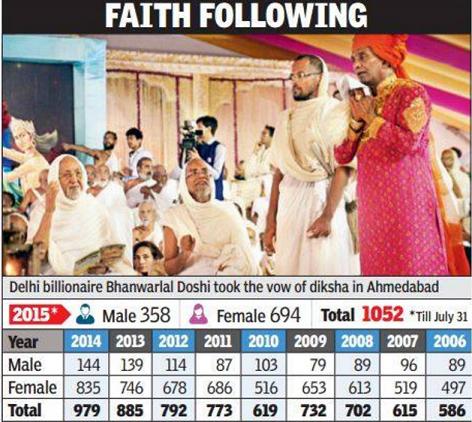 |
When Bhanwarlal Doshi took the vow of diksha, the Jain monk Bhavyaratna Vijay Maharajsaheb was born. The business tycoon was renouncing his multi-crore company, his family, his house and all the comforts of the world. He stepped off the ship to embark on a journey that required him to pluck his hair, wrap a white linen cloth around his body, and live the life of a monk.
In February nine other high-flying professionals including doctors, advocates and engineers, signed up for monk hood under Namramuniji Maharajsaheb. In the 12-month period from August 1, 2014. to July 31, 2015, the community saw the largest count of people taking the vow of diksha or complete renunciation. Doctors, lawyers, businessmen and even teenagers were among those taking the route to monk hood.
When young Jain girl scored 89% in her class 10 exams, teachers counselled her to take up science and study medicine. Little did they know that she would choose a very unique path, she decided to take diksha.
Today, initiates like Rupali, have pushed the number of monks from the community to a whopping 16,000. In 1986, there were 9,426 monks, and their numbers rose by a mere 836 over the next decade. This despite the fact that there are about 1,200 deaths among Jain monks each year.
Equally remarkable is the preponderance of women, three times more than the number of men, taking diksha. Of the 16,008 Jain monks currently living in temples and upashreyas, 12,066 are sadhvis; another 3,942 are male monks. The extreme rigors of living conditions is no hindrance to those who have made up their minds.
JAINS INVOKE AHIMSA TO DEFEND OPEN DEFECATION
September 27th, 2015: New Delhi: A section of the Jain community wants an exception for their saints who say open defecation is part of the religion. The Digambar Jains have approached the Centre against a ban on open defecation because their Munis consider it a religious ritual and that is how they answer the call of nature. The community is concerned about the goals of the Swachh Bharat mission, which aims at 100 per cent open defecation-free India by 2019.
 |
Rajasthan-based Dharam Bachao Andolan Samiti has written to several leaders in the NDA government to exempt their saints from the open defecation ban and treat it as a special case, keeping in mind their religious faith. The primary reason given by the community is that flushing will kill micro-organisms and killing any living organism is considered a sin in the religion.
Dharam Bachao Andolan Samiti, one of the organisations that approached the Supreme Court opposing the Rajasthan High Court order against Santhara, has early this month sent memorandums to Cabinet ministers, including Home Minister Rajnath Singh and Environment Minister Prakash Javadekar, explaining how any ban on open defecation will hurt the sentiments of the Jain community.
We are really concerned after statements by some Cabinet ministers on banning open defecation. We thought of bringing it to their notice that the practice of open defection by Digambar Jain Munis is an age-old practice and the government should exempt the community keeping in mind our religious belief,” said Hemant Sogani, a member of the Samiti and an advocate. The group is planning to take it up with many other important leaders in the days to come. If need be, they will not shy away from approaching the court.
Jains practice many rituals and the government cannot thrust anything which goes against our non-violence beliefs. If needed, we may launch a peaceful protest and take legal measures to protect our religious practices,” said Mukeshbhai Kothari Jain, who hails from Gujarat. Explaining the reason behind the Jain practice, Ramesh Jain Gangwal of Jaipur-based Jain Rajnitik Chetna Manch said that Jains consider hurting or killing any living organism as a sin and that is why flushing faeces is avoided and they believe in leaving it in open.
The practice of open defecation poses a big challenge to the Swachh Bharat mission. According to the United Nations report, “Progress on Drinking Water and Sanitation- 2014”, India still has the largest number of people (nearly 60 crore) defecating in open in the world. Swachh Bharat Abhiyan aims to construct 12 crore toilets in rural India by October 2019 at a projected cost of `1.96 lakh crore. In his Independence Day speech this year, Modi said the country had achieved the target of building nearly 4.25 lakh toilets across various schools.
AHMEDABAD LOCAL COURT SUMMONS ACHARYA KIRIT YASHURISWARJI MAHARAJ
October 21st, 2015: Ahmedabad: A local court has rejected a request made by a Jain monk Acharya Kirit Yashuriswarji Maharajagainst against whom a bail able warrant has been issued, to give him eight months time to appear in the Court as he wanted to walk all the way from Kolkata to Ahmedabad.
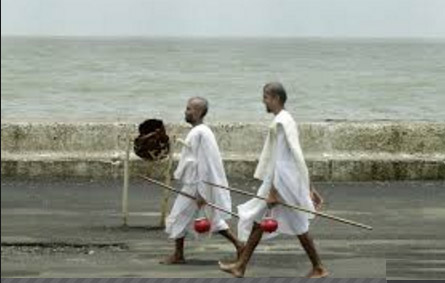 |
In the hearing held in the city-based metropolitan court, the magistrate rejected the request of the monk and has issued a fresh bailable warrant asking him to appear in the court on the next date of hearing after a month. The court had issued a warrant against Acharya Kirit Yashuriswarji Maharaj who is accused in a case of releasing forged central government notification claiming that government has given consent for Bal Diksha, the practise of renunciation of world by children among the Jains.
Chief Metropolitan Magistrate had issued a bail able warrant against him seeking his presence in court on September 7. In his reply to the warrant, the monk requested the court that he should be given time of eight months to come back to Ahmedabad. The Jain monk said that due to his age and spinal cord illness he can only walk 10-12 kms a day and it would take him eight months to return to Ahmedabad as distance between the two cities is 2,200 kms.
The monk in 2009 had issued an advertisement in local newspaper with an alleged forged notification of the Centre which said that government endorses Bal Diksha and it is not against any law. The advertisement was issued by the Jain monk after furor in the Jain community over renunciation of the world by young children. However, social activist Jasmin Shah had through RTI, found out that the Centre has never issued any such notification endorsing Bal Diksha.Complaint of forgery was filed against the monk by Shah in the court.Gujarat High Court has come down heavily on the supporters of 'Bal Diksha' and has asked whether the practice was in violation of the laws meant for protection of juveniles and the right to childhood, which is covered under Article 21 (Right to Life) of the Constitution.
SPECIAL COVER ISSUED ON JAIN SAINT JAYANAND MUNI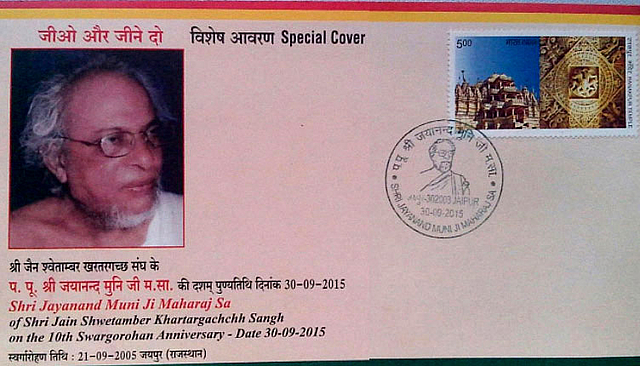 |
On the occasion of 10th Swargarohan Anniversary of Jain Saint Pujya Jayanand Muni Maharaj, a special cover was issued at Jaipur on 30th September 2015. Release function was organised at Mohanbadi, Galta Gate, Jaipur in the auspicious presence of Pujya Maitryprabh Sagarji Maharaj. Mr. J. M. Dhor, President, Jaipur Philatelic Society was instrumental in release of this special cover and special cancellation Source:
उपाध्याय पुष्कर मुनि जन्मोत्सव समारोह सम्पन्न. विशाल जनमेदनी को संबोधित करते हुए दिनेष मुनि ने कहा
षिर्डी, 25 अक्टूबर 2015। हजारों श्रद्धालुओं की आंखें मंच के पाश्र्व में लगी विश्व संत उपाध्याय पुष्कर मुनि के विशाल चित्र पर टिकीं थीं। उपसिथत संत व श्रद्धालुजन बारी बारी से गुरु पुष्कर के जीवन व उनकी शिक्षाओं से जुडे प्रवचन दे रहे थे।
|
प्रवचनों के बीच हजारों कंठों से निकलती 'जय पुष्कर - गुरु पुष्कर की ध्वनी वातावरण को गुंजायमान कर रही थी। यह अदभूत नजारा था। समारोह में महाराष्ट्र, मेवाड - मारवाड तथा मालवा मध्यप्रदेश, गुजरात, पंजाब, दिल्ली, कर्नाटक, हरियाणा, उत्तरप्रदेश, इत्यादि 12 प्रांतों के 1800 से अधिक श्रृद्धालुओं ने भाग लिया। समारोह को संबोधित करते श्रमणसंघीय सलाहकार दिनेश मुनि ने कहा कि उपाध्याय पुष्कर मुनि ने समाज को नर्इ दिशा प्रदान करने के लिए काफी संघर्ष किया। वे ऐसे महान व्यकितत्व के धनी थे जिन्होंने पूरे विÜव में प्रेम, शांति और भार्इचारे का संदेश प्रसारित किया। आज हम सभी उनके द्वारा प्रदत्त प्रेरणाओं के ऋणी हैं। दिनेष मुनि ने आगे कहा कि कई वर्षों तक उपाध्यायश्री की सेवा में रहने का सुअवसर ही मेरे जीवन की अनमोल धरोहर है। जो भी श्रृद्धालु उनके सम्पर्क में आया उसे उन्होंने रज से रतन बनने का सदुपदेश दिया। वे जप एवं तप के महान आराधक थे। उन्होंने धर्म, अध्यात्म, शिक्षा, चिकित्सा एवं साहित्य के क्षेत्र में कर्इ श्रावक तैयार किए जो समाज सेवा में अग्रणी कार्य कर रहे हैं। राजनीति में भी वे पारदर्शीता के प्रबल समर्थक थे। सच तो यह है कि वे इक्कसवीं शताब्दी के महान संत, साधक एवं आराधक थे। उनकी सबसे बडी विशेषता नवकार मंत्र का आमजन को मंगलपाठ देना रहा जिसके कारण अनेक लोग शारीरिक एवं मानसिक रोगों से मुक्त हुए। उनका जबर्दस्त प्रभाव यह रह कि वे जहां भी गए जैनेत्तर लोग भी बढी संख्या में उनके भक्त बन गये। उपाध्याय पुष्कर मुनि ने अपने उपदेशों द्वारा ग्रामीणजनों को सर्वाधिक प्रभावित किया और अनेकों को व्यसन मुक्त रहने का संकल्प दिलाया। आज भी भक्तजन उन्हें श्रद्धा से याद करते हैं।
पंडित रत्न पदमऋषि ने समारोह को संबोधित करते हुए कहा कि उपाध्याय पुष्कर मुनि ने जैनधर्म के प्रत्येक पहलुओं को बारीकी से लोगों तक पहुंचाने का काम किया। उन्हें वर्तमान के साथ भविष्य की सिथतियों का ज्ञान था। इसी वजह से उन्होंने युग की सिथति का भांपते हुए जैनधर्म को नर्इ दिशा देने का प्रयास किया। विषिष्ट अतिथि लोक सभा सदस्य दिलीप गांधी, अहमदनगर ने कहा कि पुष्कर मुनि ने अपने जीवनकाल में साधना को सर्वोच्च प्राथमिकता दी। और अपने भक्तों को भी साधना के निए प्रेरित किया। मधुरवक्त लोकेष ऋषि ने कहा कि उन्होंने प्रवचनों और व्यवहार द्वारा जीवन के उच्चतम नैतिक, मानवीय और आध्यातिमक मूल्यों को समाज के सम्मुख प्रस्तुत किया। गुरु की गरिमा हिमालय से उच्च और उज्ज्वल होती है। गुरु पुष्कर ऐसे मुनि थे जहां भौतिकता की चकाचौंध से परे आध्यातिमक उन्नयन की साधना में निरत रहे। उन्होंने जैन एकता के लिए भरसक प्रयत्न किया। डॉ. द्वीपेन्द्र मुनि ने गुरु बिन घोर अंधार की व्याख्या करते हुए पुष्कर मुनि को सभी विपत्तियों का समन करनेवाला आराधक बताया और कहा कि सच्चा सम्मान भौतिक सम्पदा वालों का नहीं होकर आध्यातिमक शकित सम्पन्न व्यकितयों का होना चाहिए और वे ही काल के इतिहास में अमर बने रहते हैं। उन्होंने आचार्य देवेन्द्र मुनि के रुप में ऐसा षिष्य तैयार किया जिसने श्रमण संघ को नर्इ उचार्इया प्रदान की।
डा. पुष्पेन्द्र मुनि ने कहा कि साधना के शिखर पुरूष उपाध्याय पुष्कर मुनि को आज भी नवकार मंत्र के आराधक तथा निर्मल,शुद्ध एवं वात्सल्य भावों से ओत-प्रोत साधक के रूप में याद किया जाता है। उनके जीवन की गहरार्इ को नापना मुशिकल कार्य है। उन्होंने अपने जीवन में कहीं अग्रता एवं उत्ताप को स्थान नहीं दिया और यहीं कारण है कि वे आज भी मानवता के मसीहा के रूप में याद किये जाते हैं। उपाध्याय पुष्कर मुनि ने समाज को नर्इ दिशा प्रदान करने के लिए काफी संघर्ष किया। वे ऐसे महान व्यकितत्व के धनी थे जिन्होंने पूरे विश्व में प्रेम, शांति और भार्इचारे का संदेश प्रसारित किया। आज हम सभी उनके द्वारा प्रदत्त प्रेरणाओं के ऋणी हैं।
मुख्यअतिथि मोहनलाल चौपडा व समारोह अध्यक्ष प्रकाष धारीवाल ने अपने जीवन पर उस महापुरुष द्वारा घटित चमत्कारों का उल्लेख करते हुए महान जपयोगी बताया। श्रीमती रुचिरा सुराणा ने उपाध्याय पुष्कर मुनि के साहित्य में नारी जीवन पर वक्तव्य देते हुए कहा कि नारी के सभी आदर्षों की महिमा उन्होनें अपने साहित्य में बतार्इ।। वे नारी स्वतंत्रता के पक्ष में तो है। लेकिन नारी के स्वच्छन्दाचार के पक्ष में नहीं है। मर्यादाओं का उल्लंघन सिर्फ नारी जीवन के लिए ही अहितकर नहीं है, अपितु वह परिवार और समाज के लिए भी अहितकर है। जैन कांफ्रेंस के राष्ट्रीय युवा अध्यक्ष महेन्द्र पगारिया ने श्रमण संघ निर्माण में महत्वपूर्ण भूमिका अदा करने वाले उपाध्याय पुष्कर मुनि के संघ निर्माण व श्रमण संघ उत्थान में महत्पूर्ण योगदान बताते हुए कांफ्रेंस की ओर से श्रद्वा पुष्प अर्पित किए। समारोह का संचालन डा. पुष्पेन्द्र मुनि ने किया और आभार रस्म उपसंघपति दिलीप संकलेचा ने अदा की।
JAIN MONK ACARYA VIMALASAGARA
(September 18, 1916 - December 29, 1994)
Among this series of seers, emerged the exalted Acarya Vimalasagara. He was a disciple of the learned Acarya Mahavirakirti, who was famed as a polyglot. Young Nemichandra received his ascetic initiation under the headship of Acarya Mahavirakirti in Sonagiri (Bundelkhand) on February 26, 1953 and became Digambar Muni Vimalasagara. In 1960, he was appointed the Acharya of the ascetic group he represented. He now headed the group of monks who were walking in the footsteps of Lord Mahavira. Such was his charisma and hold over fellow ascetics that in 1962, he was given the title of Caritra Cakravarti {Emperor Among Renouncers} and in 1979 he was accorded the title of Sanmarga Divakara {Sun of the True Path}. In 1983, he was granted the epithet of ‘Karuna Nidhi’ {Ocean of Compassion} and in 1985 he was awarded the title of ‘Vatsalya Murti’ {Embodiment of Compassion}.
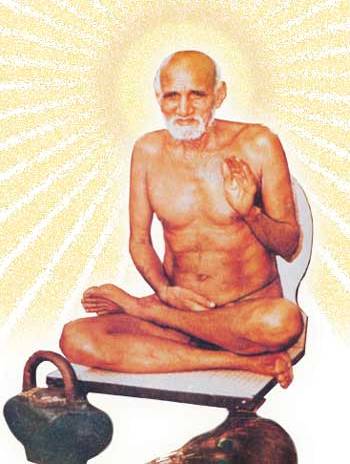 |
As a monk, young Vimalasagara was known for his extraordinary compassion, humility and his ability to serve others. His clarity of vision was astounding even at this young age. This young man lost his mother when he was an infant and was raised by his aunt Durgadevi. He left home at the age of 12 to study Sanskrit, Prakrit and Jain theology at the Morena Sanskrit Vidyalaya in Sagar (Bundelkhand).The Morena Sanskrit Vidyalaya is like the Oxford University of Jain Studies in Bundelkhand. It is the alma mater of some of the brightest Digambara Jain scholars and savants. Young Nemichand studied his classical languages and Jain theology in this haloed institute. After completing his studies, he began teaching Jainism. Simultaneously, he began spending a great deal of time serving Digambara Jain monks and learning from them. He began taking great strides on the path of renunciation by taking the vow of lifelong celibacy and chastity under Acarya Virasagara in Navan (Rajasthan). This was followed by his initiation as a Kshullaka {among Digambara Jains, the first preparatory stage before becoming a fully ordained ascetic} under Acarya Mahavirakirti in 1950 at Badavani {Madhya Pradesh}. In 1951, he was initiated as an Ailaka {among Digambara Jains, the second and highest preparatory stage before becoming a fully ordained ascetic} by Acarya Mahavirakirti. Finally, on February 26, 1953 his guru Acarya Mahavirakirti ordained him as a full fledged Digambara ascetic and he was known as Muni Vimalasagara.
The ascetic Vimalasagara was known for his deep wisdom, extraordinary ability to understand novel ideas and concepts and his earnest scholarship which ensured that the studied and internalised a large chunk of the scripture available to Jain ascetics back then and mastered the teachings of Lord Mahavira, crystalised by Gautam Ganadhara and expressed eloquently by Acarya Pushpadanta and Bhutabali, Acarya Gunadhara and Acarya Kundakunda, Acarya Samantabhadra, Acarya Umasvami, Acarya Shivarya, Acarya Pujyapada, Acarya Akalanka, Acarya Joindu and Acarya Amitagati.His mastery of the extant scripture and his scrupulous attention of nonviolence, coupled with his deeply compassionate nature and his inquisitive intellect led him to master the esoteric art and science of mantras {sacred verbal formulae}.
So wide ranging and insightful was his study of mantras that he soon won fame as the master of the esoteric sciences as described in the scriptures. He gained a massive following as the giver of solace and sound advice to all those who were troubled and felt unable to cope with the vicissitudes of life.Acarya Vimalasagara made it a point to teach his followers all that he knew and placed the greatest emphasis on honesty and ethics. He preached time and again that those who were honest and truthful would certainly benefit from their good conduct. His persona inspired many thousands of Jains and non- Jains to reexamine their beliefs and become more thoughtful and compassionate in their day to day conduct. Such was Acharya Shri’s focus on compassion and kindliness that he was known as ‘Karuna Nidhi’ {Ocean of Compassion} and ‘Vatsalya Murti’ {The Embodiment of Compassion}. It impossible to meet him and not come away inspired by his universal compassion and deep-rooted conviction in the teachings of the Jinas. Such was the strength of his faith in the Tirthankaras that he would inspire deep faith in the Tirthankaras in the hearts of his followers. This faith in turn would help his devotees attain a similar level of faith in the Tirthankaras. This faith would help them accomplish things that they had hitherto considered impossible.
They would always ascribe these accomplishments to the astonishing yogic powers of Acarya Vimalasagara. But Acarya Shri himself was very clear that each person was the doer of his own life and that he himself could only play a very tangential role in educating a person and making him aware of the vast innate potential of his soul. Acarya Shri was famed for his transparent behaviour and his absolute humility.His conduct was such that all those who came across him became his lifelong fans. He did not discriminate between people and was happy to disseminate the Jinas’ message amongst all. He was a sound scholar of Jainism and taught key Jain texts to a large number of people. So deep was his commitment to ancient scriptures that when his followers insisted on celebrating his 75th birthday, he asked them to celebrate his birthday by publishing 75 ancient texts in Prakrit/Sanskrit along with a lucid Hindi translation.He had absolutely no time for self-aggrandizement and the pursuit of the rich and the powerful. He stayed away from all kinds of publicity and despite being accessible to all those who needed his guidance, spent a major portion of his time in silence, prayer and meditation. He granted ascetic initiation to over 100 men and women who continue to walk in his footsteps, carrying the message of nonviolence, truthfulness, non stealing, celibacy and detachment from material objects.He knew when his end was approaching and walked his way to Sammeda Shikharji, the last resting place of 20 Tirthankaras. He spent his last days there. He undertook sallekhana and shed his mortal coil on December 29, 1994. Legacy: Acharya Vimalasagara exemplified the ideal conduct of a Jain monk. His imperturbable nature and calm unruffled demeanour inspire all of us to face the vicissitudes of life in a detached and phlegmatic manner.Acharya Shri’s teachings are espoused by the monks and nuns he initiated, and the lay followers whose lives he touched.Acharya Shri neither sought nor accepted fame and publicity. He stayed away from sycophants and took no interest in any sort of one up manship and politics.He was a saadhaka, first and last. He sought oneness with the supreme self and remained inwardly focused. His compassion was a byproduct of his immersion in the supreme self. Hence, it was spontaneous, effortless and universal. I bow in obeisance to this great soul. Source: Manish Modi.
CEREMONIUS RECEPTION HELD AT JODHPUR FOR A 12 YEAR BOY FOR ACCEPTING DIKSHA IN JAIN TERAPANTH SECT
A boy, named, Jitendra Pugalia, aged 12 years, an aspirant for accepting Jain Bhagwati diksha in the Terapanth sect was given a ceremonius reception at Jodhpur on the 27th October, 2015, in the holy presence of eminent sadhwi Vinayshree ji maharaj, disciple of Acharya Shri Mahashraman Ji, head of the Terapanth sect. Jitendra is presently studying in sixth standard and hails from a Jain family of Dungargarh in Rajasthan. He is presently resident of Jalgaon in Maharashtra. The reception was organised jointly by Terapanth Mahila Mandal, Terapanth Yuvak Parishad, Anuvrat Samiti and others.The Diksha ceremony will be held at Delhi on Tuesday, the 22nd November, 2015 in the presence of Muni Shri Sumer mal ji maharaj.
SANTHARA OF SADHWI RAI KUMARI CONTINUES AT JODHPUR ON THE 17th DAY AT THE AGE OF 92 YEARS
Sadhwi Rai Kumari, aged 92 years, disciple of Sadhwi Acharya Chandan Prabha Ji, belonging to Terapanth sect, having taken the vow of Santhara, has been on fast for the last 17 days at the ashram of Chandan Prabha Ji, meditating for the last 20 years. Sadhwi Ji had joined Terapanth Dharm-sangh from Acharya Tulsi at the age of 12 years and she has been following 'sayam' life for the last 20 years.
JAIN TEMPLE
PATNA CREATES REPLICA OF CHENNAI’S DIGAMBAR JAIN TEMPLE
October 19th, 2015: Patna: In Patna, the biggest attraction of Durga Puja festival this time was a replica of Chennai’s Digambar Jain Temple at Dak Bunglow Chowkh. It took the makers eight months to design the temple, which was made of steel. Amit Kumar, member of Dak Bunglow Puja Samiti, said that around Rs 10 lakh were spent in making the pandal. “The people had something different this time, they could to see Chennai Jain Temple here itself.”
 |
THIEVES STRIKE JAIN TEMPLE, FLEE WITH FOUR IDOLS
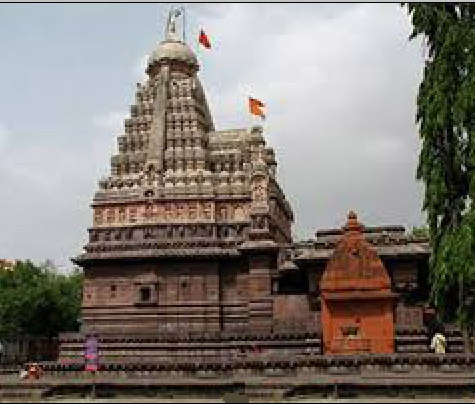 |
October 11th, 2015: Aurangabad: Unidentified suspects stole four idols from the Parshavnath Digambar Jain temple, making it the third successful theft at the temple. The police have failed to crack the earlier thefts and the temple management's step to install CCTV cameras does not seem to have deterred the culprits.
At 6.30 am, when temple priest Pandit Ambekar reached the temple for paying morning obeisance, he was shocked to find the idols missing. He soon informed the people from the locality, who rushed to the spot and found the grill of one of the windows broken. The temple priest said that four idols, including that of Lord Parshavnath, Shantilal, Nandishwar and Chowesi, have been stolen by the suspects.
Representatives of the Jain community in the city lodged a strong protest over the theft of the four idols of panchdhatu made by mixing the five metals of copper, gold, lead, silver and iron, from the temple situated at Vitthalnagar area.
Over the past year, thieves have managed to break into the temple twice and stealing the idols. The city police have not been able to detect the cases.
After the city police failed to detect the earlier two thefts, the temple committee had installed CCTV cameras within the premises. The police said that though a minor can been seen moving about in the premises, the poor quality of the CCTV cameras has hampered the probe.
The police said that it had become difficult to identify the suspect as he had covered his face. Moreover, the police have found that the suspect even made an attempt to break open the treasury box of the temple but failed in the bid. After inspecting the spot, the police even found some empty liquor bottles in the adjoining under-construction building site. Deputy commissioner of police Rahul Shrirame said, "We have visited the spot and are working to identify the suspects. We have rounded up some criminals on record and we are hopeful of detecting the case at the earliest." He said that they were closely examining the CCTV footage in which the suspect is seen carrying all the four idols one by one.
CONFERENCES, SEMINARS & EVENTS
CONFERENCE ON SANTHARA - SALLEKHANA - SAMADHIMARAN
Siddhachalam, New Jersey organised a conference to discuss the issue of Santhara on 4th October 2015 at Ahimsa Hall, Siddhachalam, Blairstown, NJ, USA. Pre Conference memorandum sent to Ahimsa Times by Shri Kulbhushan Jain, President, Siddhachalam is placed hereunder.
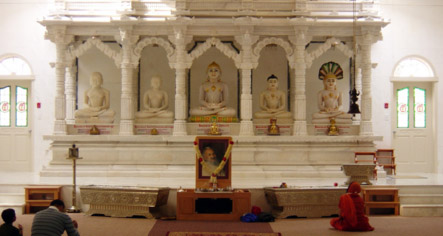 |
Santhara is a venerated Jain practice that predates our earliest scriptures, the Agams. A recent decision of a Rajasthan state High Court in India, however, declared it to be a criminal act. What is the practice and how is it an integral part of our religion? What have our scriptures to say about the practice? What are the views of the monks, nuns, scholars, lawyers and others in the laity? Is it akin to suicide? What is different about it? These and many other questions will be discussed by monks, scholars and lawyers.
Speakers at the Conference - H. H. Manak Muni (via video), H. H. Amrinder Muni, H. H. Bhattarak Charukerthi Swami (via Skype and video), H. H. Samani Suyashnidhi, H. H. Samani Shruthnidhi, Prof. Tikam Chand Jain, Yogi Shanti Parakh, and Shri Dharamraj Khot. In addition, we will also be joined by Advocate Vijay Chaoudhry who represented the Jain community at the High Court and is now representing an appellant in the Supreme Court. Moderated by Shri Jaipat Singh Jain.
Scriptures to be Discussed: The following Jain scriptures will be covered, among others: Uttaradhyayan Sutra, Acharanga Sutra, the Ashtapradhrut of Acharya Shri Kundakundaji, Antakritdasa Sutra, Avashyak Autra, Aupapatik Sutra, Tattvarth Sutra, Ratnakarand Shravakachar, Bhagawati Aaradhana, and Mrutyu Mahotsav. Additionally, legal aspects will be fully explained and clarified.
Date, Time, Venue: Sunday, October 4; 11:00 a.m. - 4:00 p.m.; Ahimsa Hall, Siddhachalam, Blairstown, NJ. Source: Kulbhushan Jain, President
AHIMSA DAY CELEBRATIONS AT UK HOUSE OF COMMONS
October 14th, 2015: London: The Institute of Jainology, the International Jain Organisation representing Jains at government and inter-faith levels, celebrated its 14th annual Ahimsa Day at the House of Commons on 14th October. The Ahimsa Award is presented annually at this event, to individuals that personify the main Jain tenet of ‘Ahimsa’ (compassion and non-violence) in their work or daily life, and this year Ann Cotton, Founder and President of Camfed was the worthy recipient.
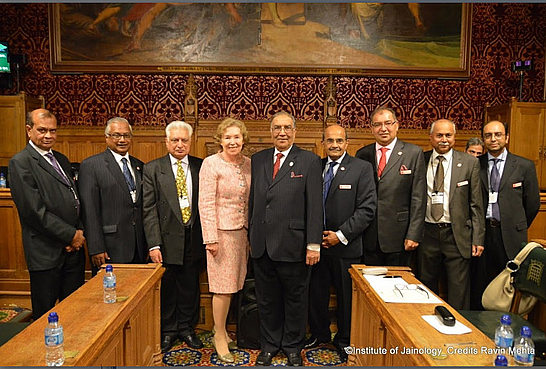 |
Camfed is a non-profit organisation which, for over 20 years, has supported girls in sub-Saharan Africa through school and into independence. Camfed’s programmes have already benefitted more than 3.5 million students in the poorest districts of Zimbabwe, Ghana, Zambia, Tanzania and Malawi. The spirit of the event was set by the inauguration in the traditional Jain fashion, with the recitation of the Navkar Mantra by two Saminijis from Jain Vishwa Bharti. Several UK parliamentarians attended the event and there were speeches from Lord Dholakia, Mr Barry Gardiner MP, Mr. Alok Sharma MP, and our Chief Guest, Mr Gareth Thomas MP.
The Chairman of the Institute, Nemu Chandaria OBE, welcomed guests and Mr Jaysukh Mehta, Director of the Institute of Jainology announced the award to Ann Cotton. Nemu Chandaria, OBE, Chairman of the Institute of Jainology, said: “We are delighted that Ann Cotton OBE has accepted the 2015 Ahimsa Award for her work in educating young women in Africa. She adds to the prestigious list of previous winners, which includes H. H. the Dalai Lama and HRH The Prince of Wales.”
In her acceptance speech, Ann Cotton describes the extraordinary returns of investing in girls’ education. “I am truly honoured to receive this award,” says Ann Cotton. “24 years ago, my journey started with the understanding that poor parents share the universal desire for education for their children. No family in our experience has ever turned down educational support for their daughter. And so Camfed has worked for more than two decades in partnership with poor families, transforming this desire for girls’ education into reality, and showing the measurable benefits of girls’ education for all of us. She also highlighted that “Girls’ education is a human right. And along with its fundamental justice it promises so much for the individual, for her family, for society, for all of us,”
About Ahimsa Day and the Ahimsa Award: Ahimsa Day was invented by the British Jain diaspora and has been celebrated annually in London since 2002. Created to underline the universality of Jainism and to publicly identify it with the concept of non-violence, Ahiṃsā Day is marked by all Jains in the United Kingdom. It is added to traditional Jain religious festivals and is a new sign of the Jain presence in the UK. Each year the Ahimsa Award is given to someone who has spread knowledge of Jainism or promoted Jain principles such as non-violence.
Institute of Jainology: Institute of Jainology was established following the first International Jain Conference held in London in 1983, when the need for an organisation to coordinate Jain affairs internationally was recognised. The Institute has offices in London and Ahmedabad, India. Its aims are to promote the Jain philosophy through art, culture and education. For more details see www.jainology.org. For More Information Contact; E-Mail: Institute of Jainology Limited, Unit 18, Silicon Business Centre, 28 Wadsworth Road, Perivale, Greenford, Middlesex UB6 7JZ, UK. Source: Jaysukh Mehta, UK, E-Mail:
MESSAGE TO IOJ BY THE UK PRIME MINISTER: DAVID CAMERON
 |
Autumn traditionally brings with it dark nights, but these are lit up every year, not only by the magic of Diwali, but also by Ahimsa Day. For me, when I think of Jainism, I think of the care and compassion it offers for every living thing and this award is the embodiment of what every Jain stands for.
We often hear news about fear, threat and uncertainty in this world, but the wonderful spirit that Jainism has brought to this country can fill us all with hope for a better future. It embodies British values of understanding, cooperation and equality, which have forged ties with others from outside their own community.
Let me also pay tribute to the Institute of Jainology on their 25th anniversary. They have played an instrumental role in driving forward initiatives to promote Jainism, through education, culture, or awards such as this one.
Following in the distinguished footsteps of Nelson Mandela and the Dalai Lama, let me congratulate this year’s winner, Ann Cotton of CAMFED; I hope that we can all learn something from her endeavours. October 2015. 10 Downing Street, London Sw1a 2AA
MISCELLANEOUS NEWS ITEMS
STATE WISE JAIN POPULATION DATA - GOVT. OF INDIA 2011 CENSUS | ||||||
| No. | STATE | TOTAL NO. 2011 | TOTAL MALE | TOTAL FEMALE | TOTAL NO. 2001 | DECADAL GR |
| 01 | JAMMU & KASHMIR | 2490 | 1310 | 1180 | 2518 | -1.11 |
| 02 | HIMACHAL PRADESH | 1805 | 945 | 860 | 1408 | 28.20 |
| 03 | PUNJAB | 45040 | 23560 | 21480 | 39276 | 14.68 |
| 04 | CHANDIGARH | 1960 | 997 | 963 | 2592 | -24.38 |
| 05 | UTTARAKHAND | 9183 | 4747 | 4436 | 9249 | -0.71 |
| 06 | HARYANA | 52613 | 27358 | 25255 | 57167 | -7.97 |
| 07 | NCT OF DELHI | 166231 | 85605 | 80626 | 155122 | 7.16 |
| 08 | RAJASTHAN | 622023 | 317614 | 304409 | 650493 | -4.38 |
| 09 | UTTAR PRADESH | 213267 | 110994 | 102273 | 207111 | 2.97 |
| 10 | BIHAR | 18914 | 9743 | 9171 | 16085 | 17.59 |
| 11 | SIKKIM | 314 | 181 | 133 | 183 | 71.58 |
| 12 | ARUNACHAL PRADESH | 771 | 371 | 400 | 216 | 256.94 |
| 13 | NAGALAND | 2655 | 1373 | 1282 | 2093 | 26.85 |
| 14 | MANIPUR | 1692 | 862 | 830 | 1461 | 15.81 |
| 15 | MIZORAM | 376 | 208 | 168 | 179 | 110.06 |
| 16 | TRIPURA | 860 | 453 | 407 | 477 | 80.29 |
| 17 | MEGHALAYA | 627 | 342 | 285 | 772 | -18.78 |
| 18 | ASSAM | 25949 | 13543 | 12406 | 23957 | 8.31 |
| 19 | WEST BENGAL | 60141 | 30718 | 29423 | 55223 | 8.91 |
| 20 | JHARKHAND | 14974 | 7763 | 7211 | 16301 | -8.14 |
| 21 | ODISHA | 9420 | 4885 | 4535 | 9154 | 2.91 |
| 22 | CHHATTISGARH | 61510 | 31592 | 29918 | 56103 | 9.64 |
| 23 | MADHYA PRADESH | 567028 | 291937 | 275091 | 545446 | 3.96 |
| 24 | GUJARAT | 579654 | 294911 | 284743 | 525305 | 10.35 |
| 25 | DAMAN & DIU | 287 | 147 | 140 | 268 | 7.09 |
| 26 | DADRA & NAGAR HAVELI | 1186 | 632 | 554 | 864 | 37.27 |
| 27 | MAHARASHTRA | 1400349 | 713157 | 687192 | 1301843 | 7.57 |
| 28 | ANDHRA PRADESH | 53849 | 27473 | 26376 | 41846 | 28.68 |
| 29 | KARNATAKA | 440280 | 225544 | 214736 | 412659 | 6.69 |
| 30 | GOA | 1109 | 580 | 529 | 820 | 35.24 |
| 31 | LAKSHADWEEP | 11 | 6 | 5 | 0 | |
| 32 | KERALA | 4489 | 2225 | 2264 | 4528 | -0.86 |
| 33 | TAMIL NADU | 89265 | 45605 | 43660 | 83359 | 7.09 |
| 34 | PUDUCHERRY | 1400 | 702 | 698 | 952 | 47.06 |
| 35 | ANDAMAN & NICOBAR ISLANDS | 31 | 14 | 17 | 23 | 34.78 |
| TOTAL | 4451753 | 2278097 | 2173656 | 4225053 | 5.37 | |
COMMUNITY INSURANCE POLICY
October 22nd, 2015: Mumbai: Naypadmasagar Maharajsaheb the founder mentor of JITO and JIO is the inspiring force behind community insurance policy. In the words of Naypadmasagar Maharajsaheb "we have been working on health insurance for a long time. The new idea can change the dynamics of insurance policies. It will ensure better deals to members of a community. Other communities or groups can adopt a similar policy.
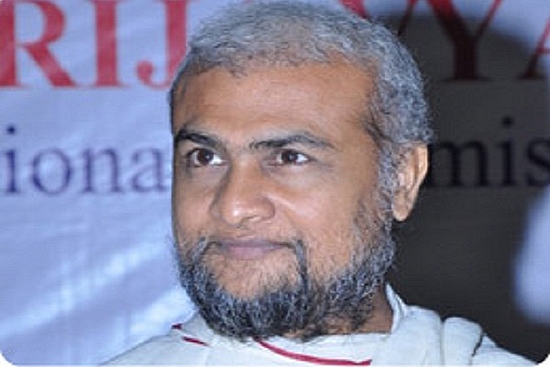 |
A new deal in medi-claim insurance sector is open to the Mumbai Jain community that looks after their most essential expenses of life-the health insurance. The health will ensure better benefits for the Jain community at large. That would be better than insurance worked out for individuals or their families.
"We have been working on health insurance for a long time. The new idea can change the dynamics of insurance policies. It will ensure better deals to members of a community. Other communities or groups can also adopt a similar policy," said Naypadmasagar Maharajsaheb, the inspiration behind 'JIO High Networth Individual Mediclaim Policy', unveiled for the Mumbai Jains.
The mediclaim policy aims to give those, not part of the corporate world, good insurance deals on a par with corporate-level deals, that could also sometimes give more benefits. "People would ideally have been paid at least twice the amount at the individual level for a similar deal, which also would not ensure maximum benefits," added Naypadmasagar Maharajsaheb.
The policies are worth Rs. 15 lakh and Rs. 20 lakh and a maximum of seven members of a family can be covered. No prior medical tests are required. The premium is Rs. 44,000 and Rs. 59,000 respectively.
"There are better and clearer benefits than individuals opting for family floater medi claim policy. All ailments, including pre-existing diseases, even for 80-year-olds, are covered for life," said Dr. Bharat Parmar, President of Jain Doctors' Association, who is part of the policy deal. According to industry insiders, for most cases tests are required and medi claim is restricted to an upper limit of 80 years of age.
He added, "Besides that there will be air-ambulance facility up to Rs. 2.5 lakh, hospital allowance, robotic treatment, cochlear and laser treatment of eye to the tune of 50 % among others besides giving accident cover to the primary member." However, this is open to only members of the Jain International Organisation, inspired by a Jain monk. Membership to the organisation is free. "The Insurance Regulatory and Development Authority guidelines mandate that the group needs to be defined and hence Jains who are not part of the organisation can't avail of it," said Parmar.
SANSKAR VATIKA'S FOR CHILDREN AT AHEMDABAD
October 5th, 2015: Jain leaders in Ahemdabad have started an initiative called 'Sanskar Vatika' which aims to inculcate cultural values among youngsters. The basic idea of the initiative is to teach students the values of Jainism and Indian culture and guide them towards becoming good human beings.
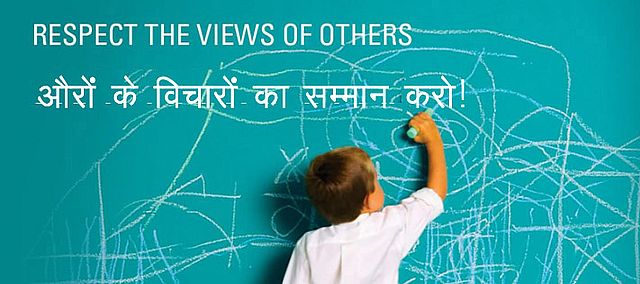 |
The initiative was launched at Sabarmati in presence of Jain monks and pandits. The initiative, which already has 550 participants in the age group of 6 to 11, will impart knowledge on Jain philosophy and history. The children will also be taught Indian history. The initiative is being spearheaded by Shree Jain Dharma Tatvagyan Pracharak Parishad, an organization that is dedicated to spreading knowledge on Jain philosophy.
Parishad's honorary secretary Vasant Pandit said, "We believe that children should get the sanksars of Arya Civilisation along with their modern schooling. We got this inspiration from the Jain community down south. After discussing with Jain Acharyas, pandits and teachers, we have decided to start sanskar vatikas in the city. Children today waste so much time playing on electronic gadgets. We want them to utilize their time for constructive purposes.
We have the blessings of Acharya Padmasagarsuriji and other Jain Acharyas and support of city's prominent Jains like Samveg Lalbhai, Shreeyak Arvindbhai etc." This initiative is the need of the hour. Our motto is that children should learn gruhshanti, respect parents and become socially aware. Today, with the hectic schedule and other distractions, children don't spend much time with their family. We need to show them the correct direction," said Dinesh Mehta, secretary of the Parishad.
AM I A CRIMINAL? ASKS 96-YEAR-OLD CHIMMAN LAL JAIN
October 6th, 2015: Agra: The 96-year-old freedom fighter Chimman Lal Jain, who had threatened to end his life by jumping into the Yamuna on October 2, Gandhi Jayanti, to protest sale of liquor, was put under house arrest after he left his house without informing about his whereabouts to anyone. Jain was promptly traced and brought back to his house around 9 pm by alert police who had been deployed in the locality following his death threat.
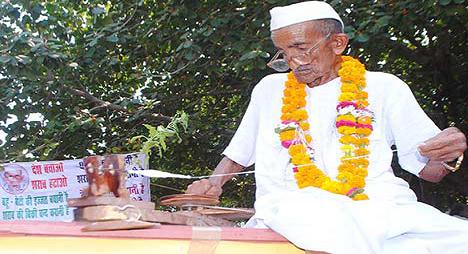 |
Agitated by his house arrest, Jain alleged that he is being treated as a 'prisoner' by police who stand vigil even as he uses the bathroom. Calling it a 'death of democracy', he said, "Why have they put me under house arrest? Am I a criminal? I just want a ban of the sale of liquor which is bad for society. Murderers and rapists are meanwhile roaming free. But I am being put under arrest for bringing attention to a serious problem haunting the nation."
Meanwhile, an announcement was made by Brijendra Singh, state head of UP Madhyamik Shikshak Sangh, on behalf of thousands of his followers that they will go about setting liquor vends on fire if any harm comes to Jain. Singh claims to have the support of more than 90 education centres and nearly 20,000 students across the district. Hundreds of Jain's supporters gathered outside his house after news spread of his house arrest. A few Aam Aadmi Party and Congress leaders also met Jain and extended their support.
Recently Jain also found support from anti-corruption campaigner Anna Hazare. Rajendra Singh, a follower of Anna Hazare met Jain three days ago and conveyed a message of support, urging Jain not to make good his threat of jumping into the river. "We are not going to let this campaign end. Our protests will continue. How long will they keep him under arrest? We shall plan a new strategy to ensure ban of liquor sale when he is set free," said Singh.
77-YEAR-OLD ON SANTHARA DIES IN ASSAM
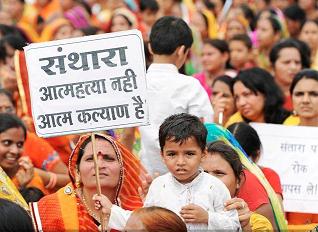 |
October 7th, 2015: Guwahati: A 77-year-old man died as a result of the Jain practice of Santhara here. Summermal Duggar from Kolkata, who was living with his daughter here, went without food for the last nine days.
Duggar belonged to the Terapanth Jain Samaj, one of the many Jain societies. A close acquaintance of Duggar said the Terapanth Samaj in Assam had thrown up many instances of Santhara, an act of facing death voluntarily in search of salvation, earlier."The person was 77. He was practising Santhara for the past nine days and successfully completed the act. He passed away on Monday," the acquaintance said.
Santhara is a traditional practice among members of the community. Ardent followers, at the fag end of their lives, can choose to end their lives by eschewing food and water. The community believes it helps clear the soul of bad karma. The practice has been a subject of controversy recently after the Rajasthan high court termed it 'illegal and punishable under Sections 306 and 309 (abetment to suicide) of the Indian Penal Code (IPC)' on August 10. In its order, the court said any support to Santhara by a person would amount to abetment to suicide and invite punishment.
FOUNDATION CEREMONY OF THE NEW CAPITAL ANDHRA PRADESH WAS NAMED AMRAVATI ON THE 21ST OCT. 2015, WITH CHANTING OF NAVKAR MANTRA IN THE PRESENCE OF CHIEF MINISTER, SHRI CHANDRABABU AND MANY OTHER DIGNITARIES
JAIN EDUCATION
SHRI PARSHVANATH PRESIDENTIAL CHAIR IN JAIN STUDIES ANNOUNCED UNIVERSITY OF CALIFORNIA
October 24th, 2015: Funded by $6 million in donations, the School of Humanities at the University of California, Irvine has announced three new endowed chairs in Jain, Sikh and modern India studies. The Chairs are named Shri Parshvanath Presidential Chair in Jain Studies, the Dhan Kaur Sahota Presidential Chair in Sikh Studies, and Swami Vivekananda-Dharma Civilization Foundation Presidential Chair in Modern India Studies. Donations of $4.5 million, plus another $1.5 million from the Office of the California University President, will fund these chairs, intended to expand UCI's scholarship in South Asian religions and culture.
 |
The Jain Studies chair has been set by Drs. Meera and Jasvant Modi and their children - Dr. Rushabh and Shruti Modi and family, Rajesh "Raju" and Neeta Shah and their children, Avani and Aakash Shah and family. The chair holder will be a scholar with wide-ranging knowledge of, and research interests in, Jain ethics, philosophy, religion, history and culture, including the fundamental principles of Jainism - nonviolence, no possessiveness and a pluralistic perspective - and familiarity with Indian languages such as Sanskrit and Prakrit.
The Chair is named in honour of Bhagvan Parshvanath. Earlier this year, Dr. Ushakant Thakkar, chairman of the DCF, and his wife, Irma, contributed $1.5 million to establish the Thakkar Family-Dharma Civilization Foundation Presidential Chair in Vedic and Indic Civilization Studies."The establishment of three endowed chairs in South Asian religious studies within the School of Humanities is a prime example of how UCI is a vibrant intellectual and cultural centre with strong ties to its community," said Chancellor Howard Gillman.
California University's religious studies programme is directed by Miles, who was awarded a Pulitzer Prize in 1996 for his book God: A Biography. "2015 will be remembered as annus mirabilis - a year of wonders - in the history of religious studies at UCI," Miles said. "Thanks to the vision and great generosity of these leaders in the Indian American diaspora - a community of 3.2 million that well represents world religions in microcosm - Orange County will now become a major centre for the study of the religions of India." Georges Van Den Abbeele, dean of the School of Humanities, said: "By integrating Jain, Sikh and modern Indian studies into our curriculum we're creating a panoramic study of India's rich cultural, historical and religious traditions."
AHIMSA NON VIOLENCE AND VEGETARIANISM
JAINS SHOULD FAST DURING EID AL-ADHA - HEMCHANDRA SURISHWARJI MAHARAJ
September 24th, 2015: Mumbai: After the controversial meat ban for Paryushan, the city's Jain community has decided to take a subdued approach towards the upcoming Eid al-Adha, also known as Bakra Eid, during which a large number of goats get sacrificed. In an attempt to compensate for the killings, Jain sadhus have asked the community observe 'Ayambil'- a fast wherein community members are expected to eat only cereals and non-sprouted pulses once a day.
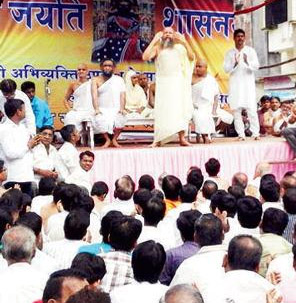 |
Messages to this effect are being spread through the community via social media and the spiritual heads are hopeful that more than 50,000 Jains across the city will abstain from food with oil, ghee, sugar, spices, etc. "We do understand that it is an important occasion for the Muslim community and offering sacrifice is a part of it. We cannot stop them from following their traditions but we want to compensate from our end," said Hemchandra Surishwarji Maharaj, a Jain sadhu for the last 43 years. Surishwarji has sent out over 1,000 forwards and has been advising his followers to abstain from full cooked meals.
"As Jains, we are against jeev hatya (killing living beings). During my pravachans in the past few weeks, I have asked everyone to compensate for the same," he said, adding that 'Ayambil' is a kind of Jain fast where the members do not eat oil, ghee, sugar, spices, rice, green vegetables and anything white. They eat only once a day and partake of only boiled or roasted cereals or non-sprouted pulses.
According to Sadhvi Viral Rasa, who has been addressing her followers in Null Bazaar, it becomes difficult for the community to know that several innocent animals will be killed. "Many from the community abstain from food on such days without us advising them. But when we give out such diktats, more members of the community will observe the fast," said Rasa, adding that the ideas is to get as many members as possible to observe the fast.
Many from the community are also spreading messages addressing the Muslim community by requesting them to sacrifice something else that is dear to them instead of the goats. "If our message reaches even one Muslim brother and he decides to change his mind and give up on a food item dear to him instead of sacrificing a goat, it will be an achievement for us," said Surishwarji.
MUMBAI MEAT BAN: THE POLITICS
September 20th, 2015: Mumbai: The recent row over ban on the sale of meat in Mumbai during a Jain festival has exposed a fault line that goes to the gut of the matter a growing veg vs non-veg divide in the city, and how politicians have made a meal of it.
In her nine-yard orange sari, hands on hips, Navina Gholap strikes a combative pose. Then, the “chairman” of the 81-year-old Lalbaug fish Mumbai market, talks. “My great-grandfather did business here, so did my father, my mother and now me. We are Kolis and the fish market is much older than any of these tall towers that you see around you. Women from these rich houses crinkle their noses and press their dupattas to their face when they pass our fish market. It is insulting. This is, after all, our food, our livelihood. Anyone who wishes any ill to our fish market will be cursed forever,” says Gholap, 50.
The recent outrage over the ban on sale of meat in Mumbai for four days during the Jain festival of Paryushan (the High Court later stayed it, and on Thursday, the Supreme Court refused to quash the stay) has exposed a faultline that goes to the gut of the matter - the vegetarian versus non-vegetarian divide in the city and how politicians have made a meal of it. In several parts of cosmopolitan Mumbai, this divide has been the cause of simmering tension for years, an undercurrent that runs through areas such as this part of Lalbaug.
On one side of the fish market is a cluster of high-rises, inhabited mostly by Gujaratis and the trading community of Marwaris, a majority of them followers of Jainism and strictly vegetarian. Shailesh Jain, who lives in Vijay Residency, one of the residential towers that overlooks the fish market, says, “We usually don’t mind the market. We have even got used to it. We just want to co-exist in peace. But on certain days of the week, when the garbage truck comes to clear the refuse from the market, the entire place stinks. It is unbearable.
We are not unreasonable. But everyone will say they want the fish market to shut down. It is only practical,” says Jain, who has a real estate office in the same building. He thinks the fish market, with its 112 licensed fish sellers, should make way for a mall and the fisherwomen can be given some “space in one corner”.
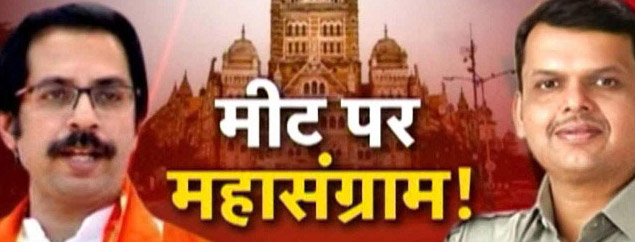 |
The Lalbaug-Parel belt was a predominantly Marathi heartland till the late ’90s but that’s changing, like several other areas of Mumbai where old industrial estates and vast defunct mill lands have given way to luxury houses and skyscrapers. With the prices of these houses running into crores, it is mostly Mumbai’s rich-the diamond brokers, stock traders and established entrepreneurs, most of them traditionally vegetarian Gujarati and Marwari families-who have moved in.
Mohsina Mukadam, food historian and head of the history department at Ramnarain Ruia College, says it’s only over the past decade that food has emerged as a polarising factor in certain parts of Mumbai. She says that when the city’s chawls - where people shared walls, and food, with neighbours-made way at some places for high-rises, something snapped. “In the chawls, people would live right next to each other and never have a problem with each others’ eating habits. Even if they did, they didn’t comment. But that’s changed over the last 10 years and certain areas have become homogenous spaces. The population of Gujarati and Marwari Jains in areas that were earlier predominantly non-vegetarian has gone up. They have the numbers and money power and have become more vocal about their opposition. It becomes a bigger problem when they think they’ll find political support.”
It is politics that makes the debate somewhat less palatable, even feeding into the larger regional insecurities of Maharashtrians versus Gujaratis. Even within the BJP-Shiv Sena alliance, the two parties have taken diametrically opposite stands, each with an eye on its votebank. In the recent meat ban case, the BJP, which draws its support from the trading community in the city, largely Gujaratis and Jains, supported the ban. The Sena opposed the ban since it would have affected the Marathi population, which eats largely fish and poultry. Last year, political parties fought the elections to the state Assembly in Mumbai by pitting the Marathi and Gujarati communities against each other. In its campaigns, the Shiv Sena, which split with its old-time alliance partner before the polls only to join the government later, highlighted how traditional Marathi bastions in Mumbai were no longer dominated by people from the state and how Marathi food and culture were under threat.
“I am going to demand the closure of abattoirs even on festivals like Ram Navmi, Krishna Janmashtami and Diwali. No one is asking anyone to change their eating habits. Yeh bas bhavna ka sawaal hai (It is a question of faith),” says Raj Purohit, BJP MLA from south Mumbai who was among the party leaders who had been vocal about a cow slaughter ban in Maharashtra.
Shiv Sena MLC Neelam Gorhe says she knows for certain that food intolerance didn’t belong to the Mumbai she grew up in. “Culturally, Mumbai is changing. People are not as considerate as they were earlier and there is a distinct lack of tolerance for each others’ food habits. The state government has been silent on the entire issue. Everyone knows who is politicising this issue,” she says.
*** About 200 metres from the Lalbaug fish market, butchers are at work skinning and cleaning broilers. “Yes, this area is changing. But that has not affected us because, so far, only about 30 per cent of the population is vegetarian. The other 70 per cent are still Marathis and some Muslims, who eat non-vegetarian. If tomorrow, vegetarians end up being the majority, then there might be objections to our business,” says Rafeeq Amin, who owns a chicken shop in Lalbaug.
Some would say the distant possibility that Amin voices for Lalbaug is the present reality in one of Mumbai’s priciest and toniest areas, Nepean Sea Road. The locality, which has one of the finest views of the Arabian Sea, is spread across 25 square km in southern Mumbai and is home to a majority Jain population. Nepean Sea Road does not have a single restaurant that serves non-vegetarian food or a shop that sells meat, not even packaged, processed meat. Grocery stores don’t stock eggs, which are available only at roadside paan-beedi shops. Gourmet bakeries that line the uphill streets of Nepean Sea Road too have eggless and “Jain varieties” on their shelves.
“Cooking non-vegetarian here involves elaborate planning,” says a 50-year-old Muslim homemaker who shifted to Nepean Sea Road last year after her husband got a transfer to Mumbai. Speaking strictly on condition of anonymity, she says, “The nearest meat market is about 2.5 km away, at Grant Road. It’s not very hygienic, so we prefer buying our meat or chicken from supermarkets in Churchgate, which is over 6 km away. It costs more than Rs 100 just to get there by taxi. So if we crave for a good meal of chicken one evening for dinner, it won’t happen unless we plan much in advance,” she says.
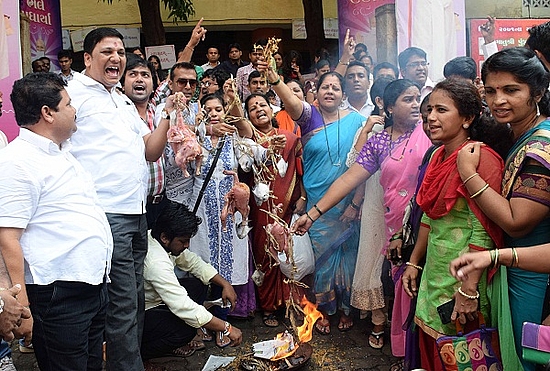 |
The only restaurant serving non-vegetarian as well as vegetarian food on Nepean Sea Road closed more than a decade ago, after shrill protests. Residents had staged a demonstration against ‘Roti’, saying the restaurant was breaching the sanctity of the place where mostly Jains live.
Several other food chains, including coffee giant Starbucks, have unquestioningly fallen in line while launching outlets in ‘vegetarian areas’. Last year, the “world’s biggest coffee chain” opened a store at Girgaum Chowpatty, a four-minute drive from Babulnath temple in south Mumbai, becoming Starbucks’s first and only ‘pure veg’ outlet in Mumbai. Similarly, in 2012, Mumbai-based Chinese food chain Five Spice, which is known for its exhaustive menu of chicken and sea food fare, had launched with a “pure vegetarian” menu at two of its outlets-Charni Road in south Mumbai and Kings Circle in Matunga, central Mumbai. While Charni Road has a significant Jain population, Matunga is populated by Gujarati and Marwari Jains as well as Tamil Brahmins, who are strictly vegetarian.
A waiter at Five Spice’s Charni Road restaurant says, “Our restaurant is in a Jain building. Cooking or eating non-vegetarian food is strictly forbidden. Besides, there was no point having chicken and fish on the menu when most of the residents in the area are vegetarian, barring a few. There are some customers who ask for non-veg food. We direct them to our branch in Fort (south Mumbai),” he says. In 2007, a group of residents in Chembur, northeast Mumbai, filed a PIL in the Bombay High Court against the opening of a kebab outlet on the ground floor of Devkinandan, a residential building with 14 flats. In their petition, they said the non-vegetarian eatery would cause communal problems as 95 per cent of the population in the surrounding area was vegetarian, many of them Gujaratis, Jains and Rajasthanis. The restaurant plan never took off.
The largely vegetarian zones aren’t restricted to any one part of Mumbai. So from Girgaum Chowpatty in the south to Kandivali in the north, and Matunga in central Mumbai to Ghatkopar in the east, the city has these confining pockets that have shut their doors on non-vegetarians.
Ashok Khamkar, 70, knows what it feels like to be kept out. The proprietor of a spice shop in Lalbaug says it still hurts to think that he was denied a house in the area because of his food preferences. “It happened about 10 years ago. I grew up in Lalbaug and wanted to move out of an old building to Kamal Kunj, the first high-rise in the area. But the builder told me I didn’t qualify since I was non-vegetarian and the other residents were mostly Jains.” Khamkar ultimately bought a house in Mahim, a 20-minute drive from Lalbaug.
Dheeraj Rathod, a real estate broker in Ghatkopar, says, “When people want to put up their homes for sale or rent, they often specifically tell us ‘non-veg party nahin chahiye (we don’t want buyers who eat non-vegetarian)’. This is common in areas such as Ghatkopar, Vile Parle, Sion Jain Society and so on,” says Rathod.
A few years ago, Sohail Chawla, a “hardcore Punjabi from Delhi”, was one such “non-veg party” looking for a house on rent in Mumbai. He was hoping he would find one in Ghatkopar, close to his office in Vikhroli. A real-estate broker in Ghatkopar very helpfully told him which areas and housing societies to keep away from. “My broker told me that a lot of owners in Presidential Towers, a housing society in Ghatkopar, had specified that they only wanted a vegetarian tenant. So I lost out on options,” says Chawla, 29, who ultimately found a house in Powai, 9 km from his workplace.
Political parties such as the Shiv Sena and the Maharashtra Navnirman Sena (MNS), who consider the city’s Marathi-speaking vote bank as their core strength, have been pushing for stringent rules against builders denying houses based on culinary preferences. Corporators, especially from the MNS, have been demanding that the civic body should withhold the Intimation of Disapproval and Commencement Certificate, two crucial clearances required for construction, for developers who deny houses to non-vegetarians.
Sixty-six-year-old Arvind Nerkar, a former Shiv Sena legislator in Girgaum, says, “It is every person’s birthright to eat whatever he or she chooses to.” Nerkar is an old-time resident of the south Mumbai area, where, like Lalbaug, old wadis and chawls are speedily making way for plush high-rises. “In the olden days, everyone lived next to each other in chawls-Gujaratis, Jains and Maharashtrians, both vegetarians and non-vegetarians. They didn’t have a problem then. But these are the same people who now stay in high-rises, who think fish and meat smell. This attitude only disturbs communal harmony,” says Nerkar. “There cannot be separate rules or concessions for different communities. We will never be able to co-exist in Mumbai this way.
” Gopal Shetty, BJP MP from Mumbai North, which has a sizeable Jain population, doesn’t echo his party’s line in favour of the ban. As someone who likes fish on his plate “at least two times a week”, he says, “A ban or any such decision has to happen after a thorough dialogue and discussion so that it doesn’t seem oppressive to a part of the population.”
MAKING, UNMAKING OF A BAN
1. In 1964, Brihanmumbai Municipal Corporation (BMC) passed a resolution directing abattoirs to be shut for two days during the eight-day Jain festival of Paryushan. In 2004, the Congress-NCP government passed another resolution endorsing the two-day ban on slaughter houses, and extended it to four days
2. Last year, the resolution was tweaked to ban sale of meat in private as well as corporation markets during the four days, requiring abattoirs to remain shut. The ban covered mutton and chicken, and excluded fish and eggs. Accordingly, for this year, all meat markets and abattoirs in Mumbai were to remain shut on September 10, 13, 17 and 18
3. In the first week of September, the BJP-ruled Mira Bhayander Municipal Corporation (MBMC) decided to impose an eight-day ban on slaughter of animals and sale of meat. The Shiv Sena and MNS protested against the decision
4. The Shiv Sena-led BMC revoked the ban for the two days, September 13 and 18. MBMC too decided to limit the ban to two days, September 10 and 17. Meanwhile, Mumbai had already observed one day of the ban on September 10.
5. On September 14, the Bombay High Court stayed the ban on sale of meat in Mumbai on September 17
6. On September 17, the Supreme Court refused to quash the High Court’s stay on the ban and said the case should be decided in the High Court.
JAINS QUIT AFTER THACKERAY ‘STING’
October 10th, 2015: Two city-based Maharashtra Navnirman Sena workers from the Jain community including Nilesh Navalakha, who is also the producer of Marathi films like Fandry and Shala resigned from the party, hurt by the 'below-the-belt' and 'belligerent' remarks of MNS chief Raj Thackeray over the ban on sale of meat in Mumbai during the Jain fasting period of Paryushan.
 |
Navalakha was joined by another key member from the Parvati area, Sachin Shingavi, while the president of MNS Lottery Sena from the city unit, Bharat Surana, already tendered his resignation a couple of weeks ago, claiming that he was offended by the regressive remarks against the community. Reacting against the Jain community's diktat to have a ban on the sale of meat during the Jain fasting period, Thackeray had said,
"Digambar Jains roam naked showing their body; if that is okay, then why this meat ban." The MNS workers even set up non-vegetarian stalls outside a Jain-dominated housing society to protest against the ban. Navalakha said, "The MNS stand and the objectionable comments by its chief have really hurt our sentiments as the comments were below the belt. So, along with Shingavi, I also decided to quit the party and mailed our resignation to the MNS main office in Mumbai." Navalakha was the MNS candidate in the 2012 civic election from Parvati (ward 66) and fought against Abhay Chajjed of the Congress.
He added that there are over 30,000 Jains in his ward and he managed to get the maximum votes from the community. "If we had not taken this decision, it could have been interpreted as the party taking the community for granted. It was necessary to take the decision as the remarks and the stand taken by MNS was below our dignity."
Word soon spread about the duo's decision, with MNS city president Ajay Shinde saying, "The issue is long over now. It is pointless to leave the party over this. I completely understand that religious sentiments of the Jain community were hurt after the incident in which non-veg stalls were set up outside a Mumbai-based society. However, that was not the party's stand or decision."
SHIV SENA TRIES TO MAKE UP WITH JAIN COMMUNITY
October 9th, 2015: Mumbai: A month after attacking the Jain community over the ban on meat sale during paryushan, Shiv Sena has tried to build bridges with the community as Yuva Sena Chief Aaditya Thackeray inaugurated a sports event organised by Jain International Trade Organisation.
 |
“There is a strong bond between Shiv Sena and the Jain community. The bond will not break even if some body tries to spoil it. It will remain intact,” Aaditya said at the event. The event was organised by JITO, a body of top Jain industrialists, builders and leaders, at the National Sports Club of India in Worli in South Mumbai.
In September, the Shiv Sena had aggressively criticised to the eight days meat ban demand made by Jain community, which is backed by Bharatiya Janata Party during paryushan. However, the Sena ruled Brihanmubai Municipal Corporation announced four days ban during paryushan which did not go well with the party workers. Subsequently, Sena president Uddhav Thackeray said that they would not allow meat ban because it's the primary food of the Marathi people in Mumbai. The row over the issue was resolved after Jain community leaders met the Sena chief Uddhav Thackeray.
The party had also attacked the Jain community through its mouthpiece, Saamana, saying that Jains must not follow the path of Muslims and become fanatics. “Until now, only fanatic Muslims used to bully people in the name of religion. If the Jains too are going on the path of Muslims, then God save them. During the 1992-93 Mumbai riots, Marathis had protected Jains, who were saved because violence had been answered by violence. At that time too 'Paryushan' was on. But Jains were at the forefront of supporting violence then," an editorial in Saamna said.
Rajesh Vardhan, co-convener of event, said that though the issue was over after the controversy, we organised the event to improve the ties with Sena. “Sena doesn’t have any problem with Jain community. After the issue of meat ban sale, there were some differences and misunderstandings between the community and Sena,” said Vardhan.
So, we decided organise a sports activity and invited Aaditya Thackeray. He immediately accepted the invite and also enjoyed the activity, he added.
Political analysts say that it is imperative for Sena to get the Jain community’s backing ahead of the upcoming elections of civic bodies including Mumbai. “It is imperative for Sena to get backing of Jain community. But, for political purposes, Sena will side with the Marathi people to ensure their vote bank remains intact. Sena has never broken its ties with the Jain community. It’s a political tactic and that’s how the political parties are operating nowadays,” said Prakash Bal, a political analyst.
AWARDS AND HONOURS
SIDDHARTHA JAIN ROPED IN AS DIRECTOR BY HOTSTAR
 |
October 13th, 2015: After successfully enticing audience with a host of shows with their video on demand platform Star India's Hotstar has decided on venturing in the content creation zone. In fact we hear that Hotstar has roped in none other than iRock Production's Siddhartha Jain as the creative director for original content.
With this appointment Jain, a serial entrepreneur and film producer, will report to Star India digital head Ajit Mohan. Commenting on the same, a source states that Hotstar is hell-bent on continuing its march forward towards development of original content.
As for Jain, prior to setting up iRock that produced the Sunny Leone starrer Ragini MMS, Jain was attached with Adlabs Films where he also produced the Salman Khan and Ali Larter starrer Marigold.
NEW BOOKS
AHIMSAK SHAKAHAR - By Padmashri Sharayu Daftary, 2014 24 x 18 cm 96 pages (printed in full colour on art paper),Deluxe Hardback edition Rs. 300. The book is lucidly written and the information contained in it is accurate and up to date. Importantly, it steers clear of jingoism and bombast. Instead, it uses logic and common sense to establish its viewpoint. This book presents compelling philosophical as well as practical reasons for vegetarianism. Despite drawing on Jain teachings, its approach is universal. It is useful for anyone who wishes to attain spiritual uplift and has chosen the path of vegetarianism and self control.
Seminal points made by the author: Vegetarianism is essential for the spiritual seeker, Vegetarianism is essential for anyone who seeks good health and holistic well-being,Vegetarianism is essential for one who wishes to rid himself of sensual desire,Fasting and eating simple foods can help one attain spiritual up-liftment. This book has been printed in full colour on art paper and the print quality, layout, cover design, etc. are on par with the best in the world. The author, Padmashri Sharayu Daftary is an acclaimed business leader. Hindi Granth Karyalay, E-Mail:
JAIN MINORITY
GUJRAT JAINS SEEK MINORITY STATUS
October 4th, 2015: Ahmedabad: Members of Jain community staged a dharna at Sardarbaug in Lal Darwaza to exert pressure on the state government to notify Jains in the state as a minority community. The Union ministry of minority affairs has declared Jains a minority community through a notification in January 2014, but the Gujarat government is yet to do the same.Gujarat Jain Manch president Pramod Shah said the Jains would launch various programmes against the state government. "After Diwali, a meeting of the Jain community members will be held to decide on the programme which includes rallies in Ahmedabad and also meetings," he said.
 |
Shah claimed that the government had been dragging its feet on the issue for over a year-and-a-half and it appeared that the government was now not inclined to give Jain the minority status. "The state government is against the Jain community and it was to include Jains as Hindus. However, the state has once again failed to give Jain the status of Hindus." Sthanakwasi Jain Samaj president Praful Talsaniya said, "Even in the Jain community there are around 15-20% of the people who are not well to do. If we get minority status this 20% families will be benefitted. If the BJP government doesn't grant minority status, we will ask the community to vote against the BJP in the forthcoming local body elections." Digambar Jain Samaj president Lokesh Kodiya said that the agitation would be nonviolent and it would now be decided by the community leaders how to take it forward. "With the minority status the trust managed by the Jain will get autonomy, which will stop government interference. We will also persuade the Jain munis to support the agitation."
SOME SPECIMEN FORM FOR CLAIMING MINORITY STATUS IN OFFICIAL CORRESPONDENCE |
| (A) SELF DECLARATION FOR MINORITY STATUS BY STUDENT |
(On Rs 100 Non Judicial Stamp Paper to be attached in Original) I, *Shri / Smt. / Kum. _____________________, aged _____________________, years, s/o or d/o or w/o Shri _____________________, Residing at _____________________, hereby declare and state on oath that I belong to “Jain” Community, declared as Minority Community by Ministry of Minority Affairs, Central Government of India vide Notification No. S. O. 267 (E) dated 27th Jan 2014. If at any stage, it is found that the information given by me is false / not true, all benefits given to me under the Scholarship Schemes applicable to the students belonging to Minority Communities, could be withdrawn and legal action as deemed fit, may be taken against me. Date: -.....................2014 ___________________________ *Strike of which is not applicable. |
| (B) SELF DECLARATION FOR MINORITY STATUS BY MINOR STUDENT |
(To be filled in for & by the Minor Students) (On Rs 100 non judicial stamp paper to be attached in original) I, *Shri / Smt. / Kum. _____________________, aged ______________years, *Father / Mother / Natural Guardian of *Shri / Smt. / Kum.. _____________________, Residing at _________________________________, hereby declare that we belong to “Jain” Community declared as Minority Community by Ministry of Minority Affairs, Central Government of India vide Notification No. S. O. 267 (E) dated 27th Jan 2014. If at any stage, it is found that the information given by me is false / not true, all benefits given to my son / daughter under the Scholarship Schemes applicable to the students belonging to Minority Communities, could be withdrawn and legal action as deemed fit, may be taken against me. _________________________________________________ ________________________ *Strike of which is not applicable. Date: -.....................2014 |
From: To: Respected Sir, SUB: REQUEST TO CHANGE THE “COMMUITY / RELIGION” IN YOUR RECORDS. Apropos above, may I, *Father / Mother / Gordian of *Master / Kumari ____________________, request you, please to make the change in your records with respect to my Community or Religion as under: “JAIN” as now I belong to Jain Minority Community as declared by Ministry of Minority Affairs, Central Government of India vide Notification No. S. O. 267 (E) dated 27th Jan 2014. I shall be highly obliged of and thankful to you, of you can make the necessary changes as requested above in your Records. Yours truly, (____________________) *Strike of which is not applicable. Source: Alok Tholiya, E-Mail: |
JAIN CALENDAR - OCTOBER 2015
VIR SAMVAT 2541 JAIN CALENDAR VIKRAM SAMVAT 2071
Aatham| Chaudas | Pancham | Bij | Agiyaras | JainFestival | Auspicious Day |
BHADARVO - OCTOBER 2015 - AASO | ||||||
Mon | Tue | Wed | Thu | Fri | Sat | Sun |
| BHADARVO: 1 TO 12 OCTOBER AASO: 13 TO 31 OCTOBER | 1 Vad Choth | 2 Vad Pancham | 3 Vad Chhath | 4 Vad Satam | ||
| 5 Vad Aatham | 6 Vad Nom | 7 Vad Dasam | 8 Vad Agiyaras | 9 Vad Baras | 10 Vad Teras | 11 Vad Chaudas |
| 12 Vad Amas | 13 Sud Ekam | 14 Sud Ekam | 15 Sud Bij | 16 Sud Trij | 17 Sud Choth | 18 Sud Pancham |
| 19 Sud Chhath | 20 Sud Satam | 21 Sud Aatham | 22 Sud Nom | 23 Sud Dasam | 24 Sud Agiyaras | Baras | 25 Sud Teras |
| 26 Sud Chaudas | 27 Sud Poonam | 28 Vad Ekam | 29 Vad Bij | 30 Vad Trij | Choth | 31 Vad Pancham | |
| AVOID GREEN & ROOT VEGETABLES Date: 2 | 5 | 8 | 11 | 16 | 18| 19 to 27 | 29 | 31 AVOID ROOT VEGETABLES JAIN FESTIVAL AUSPICIOUS DAY OTHER |

